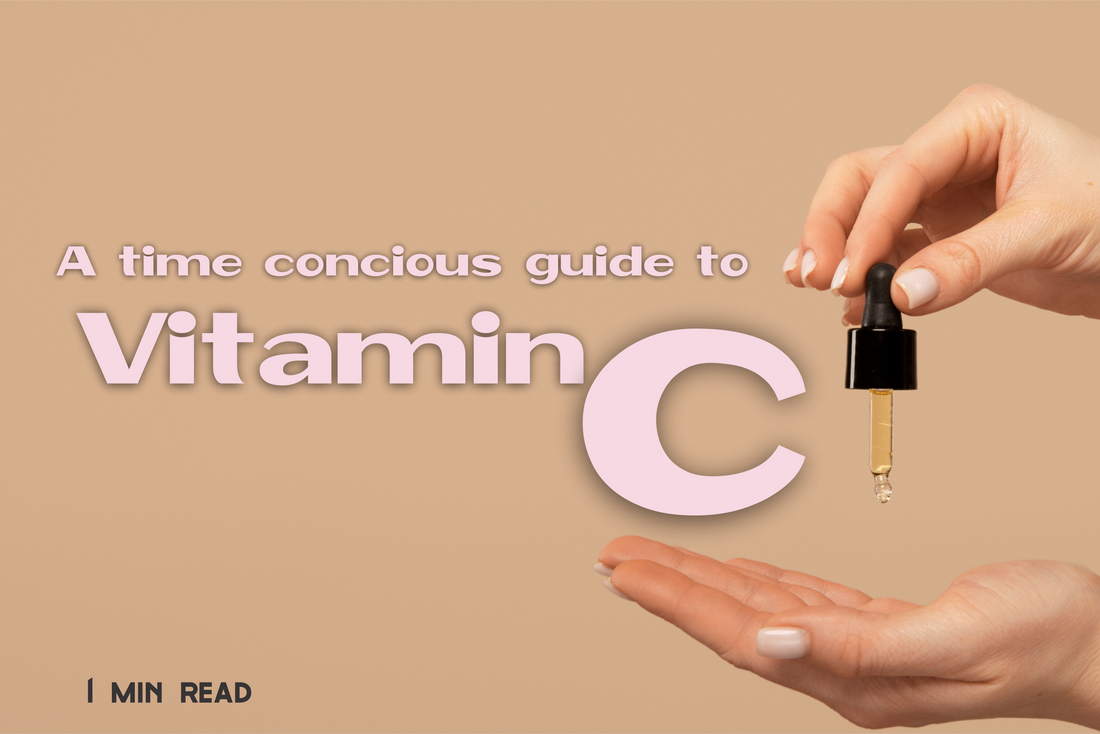
Your Guide to Vitamin C
Vitamin C Benefits
Vitamin C has long been widely accepted as a cornerstone of an effective skincare regimen. There are countless studies that show that the topical application of products with Vitamin C can:
- Scavenge free radicals and protect cellular function and DNA
- Help with the formation of collagen
- Reduce oxidative inflammation that causes cellular malfunction
- Help protect the skin from UV damage
- Increase the effectiveness of sunscreen
The Unstable Nature of Vitamin C
Vitamin C in it's bioavailable form degrades quickly in a solution or when exposed to light or oxygen because it is constantly scavenging free radicals and absorbing UV light. The wildly unstable nature of L-Ascorbic acid, however, is the very trait that makes it such a powerful and effective ingredient but these chemical reactions need to be somehow delayed until the formula is placed on the skin. The optimal way to formulate a product with L-Ascorbic acid is to keep the formula dry and isolated from moving air and light. (Which is exactly what I did). In traditional methods of formulation, where there is a water or oil as a solvent and/or the product is regularly being exposed to air and light as it is opened, L-Ascorbic acid is not the ideal form of Vitamin C to use. This is why other, more stable forms of Vitamin C have been developed. These derivatives metabolize into L-Ascorbic acid after being applied to the skin, offering close to the same benefits without the formulation difficulties.
Different forms of Vitamin C
L-Ascorbic Acid (LAA): This is the pure form of Vitamin C and is the most researched for its efficacy. It's known for its potent antioxidant properties but can be unstable and irritating in higher concentrations.
Ascorbyl Palmitate: This is a fat-soluble derivative of Vitamin C. It is more stable and less irritating than L-ascorbic acid. However, it is less potent and doesn't penetrate the skin as effectively as L-ascorbic acid.
Magnesium Ascorbyl Phosphate (MAP): This is a water-soluble derivative of Vitamin C that is more stable and less irritating than L-ascorbic acid. It is effective in lower concentrations and can be used to treat hyperpigmentation and increase skin hydration.
Sodium Ascorbyl Phosphate (SAP): Similar to MAP, this is a stable, water-soluble form of Vitamin C that is less irritating. It's known for its ability to fight acne and prevent skin aging.
Ascorbyl Glucoside: This is a stable form of Vitamin C combined with glucose. It breaks down into L-ascorbic acid over time on the skin, making it an effective antioxidant that is less potent but more stable than pure L-ascorbic acid.
Tetrahexyldecyl Ascorbate: A fat-soluble derivative of Vitamin C, it is one of the most stable forms. It can penetrate the skin deeply and effectively convert to ascorbic acid, offering significant anti-aging benefits.
3-O-Ethyl Ascorbic Acid: This is a newer, highly stable form of Vitamin C that can effectively penetrate the skin and convert to ascorbic acid. It's known for brightening the skin, reducing pigmentation, and providing antioxidant protection.
Ascorbic acid and irritation
The most active form of Vitamin C, L-Ascorbic acid is hands-down the most effective. For product stability, however, L-Ascorbic acid needs to be paired with other antioxidants and kept at a very low pH in water-based formulas. This low pH is what makes products with L-Ascorbic acid irritating to some people. Those with C-sensitivity may have more luck with an anhydrous product. Dry formulas like illumenase have the advantage of not having to be stabilized because the chemistry does not begin taking place until the moment it is used. Therefore the final pH once reconstituted does not have to be so acidic to maintain the efficacy of the L-Ascorbic acid within its formula.
What products to skip on vitamin c days.
Benzoyl Peroxide: It can oxidize Vitamin C, reducing its antioxidant ability. Additionally, using both can lead to excessive skin dryness and irritation.
Exfoliants (Physical and Chemical): Using strong exfoliants on the same day as Vitamin C might cause increased sensitivity and irritation, especially if you have sensitive skin.
Copper Peptides: Cycle these on off days. Check out how.
To minimize risks and maximize benefits:
Patch Test New Combinations: Before fully integrating new products or combinations into your routine, conduct a patch test to check for irritation or adverse reactions.
The Mirror Test
Feel a sting when you apply your Vitamin C products? This does not necessarily mean that you should not be using it. How can you tell? Take a look in the mirror. If you don't see redness or inflammation where you are experiencing the sting, then you are not having an adverse reaction to the Vitamin C product. In a few minutes, the sting will go away. The next time you apply your C product, use less in your sensitive areas until you build up a tolerance. Or if you are not keen on any sting at all, then grab some illumenase which has L-Ascorbic acid at a 14% concentration in an anhydrous formula that, when reconstituted, has a pH of 4.5 to 5.5 which is the same as our skin.
Skin-Cycle: If you're unsure about the compatibility of Vitamin C with other products in your routine, consider using them at different times of the day or on alternate days.
Consult a Dermatologist: Especially if you have sensitive skin or are unsure about product interactions, consulting with a skincare professional can provide personalized advice based on your skin type and concerns.
Each form of Vitamin C offers unique benefits tailored to different skin needs and concerns. By understanding these nuances, performing patch tests, and consulting with dermatologists when necessary, you can harness the full potential of Vitamin C to achieve a brighter, healthier, and more resilient complexion. Remember, while Vitamin C can significantly enhance your skin's appearance and health, it's essential to mind its interactions with other products and tailor its use to your skin's specific responses.
Now please go and have a quality day,
MBM
Topical vitamin C and the skin: mechanisms of action and clinical applications by F. Al-Niaimi and N. Y. Z. Chiang (2017).
Benefits of combinations of vitamin A, C and E derivatives in the stability of cosmetic formulations by M. D. Gianeti, L. R. Gaspar, and F. B. Camargo Júnior (2012).
Vitamin C: One compound, several uses. Advances for delivery, efficiency and stability by A. C. Caritá et al. (2020).
Study on preparation of a chitosan/vitamin C complex and its properties in cosmetics by L. Liping et al. (2020).
Cosmetics Formulations containing Vitamin C and The Instability Challenge by J. D. Shultz, A. C. Caritá, and H. Mohd (2022).

